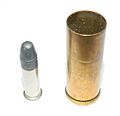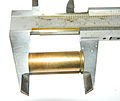.45 Colt
| .45 Colt | |
|---|---|
| general information | |
| caliber | .45 Colt, 11.4 × 33 R |
| Sleeve shape | Edge sleeve with pull-off groove |
| Dimensions | |
| Sleeve shoulder ⌀ | 12.2 mm |
| Floor ⌀ | 11.58 mm |
| Cartridge bottom ⌀ | 13.11 mm |
| Sleeve length | 32.64 mm |
| Cartridge length | 40.64 mm |
| Weights | |
| Bullet weight | 13.0-16.2 g (200-250 grain ) |
| Powder weight | 1.944–2.55 g (30–40 grain ) |
| Technical specifications | |
| Speed v 0 | 270-315 m / s |
| Max. Gas pressure | 1100 bar |
| Bullet energy E 0 | 650-700 years |
| Lists on the subject | |
The .45 Colt (also .45 Long Colt ) is a widely used revolver cartridge.
history
The .45 Long Colt centerfire ammunition has been with the Colt Single Action Army in 1873 as an orderly of the US Army accepted. It had a copper case with an internal Benét fuse (patent Benét). This was pushed into the sleeve from the front and fixed with two notches from the outside. It was therefore not possible to reload these cartridges. From 1875 onwards, shorter cartridges with cases shortened from 32 to 28 mm were issued in order to enable them to be used in the Smith & Wesson-Schofield revolver, as this drop barrel revolver had a shorter barrel. In addition, the edge of the case was widened a little to ensure that the automatic ejector of the S&W Schofield works properly. At the same time, the powder load of the orderly cartridge was reduced from 30 grains of black powder to 28 grains (civilian .45 Long Colt ammunition was loaded with up to 40 grains) and the projectile was lightened from 250–255 grains to 230 grains. Nevertheless, this ammunition still had an enormous man-stopping effect . In 1878 experiments were carried out with cartridges containing three bullets. These spheres weighed 110 grains each and the powder charge was 25 grains. Tests have given good results at close range, and it has also been found that the recoil of the weapon almost doubled. In 1879/1880 9,300 of these cartridges were delivered to the troops, after which the tests were no longer continued. From 1882 brass cases with boxer ignition were used, which made it possible to reload several times.
The Colt Single Action Army as well as the ammunition remained orderly of the US Army and were issued until 1892. After successor models in caliber .38 Long Colt had not proven themselves in combat use, the decommissioned .45 revolver with barrels shortened to 5½ inches were reintroduced during the Spanish-American and Philippine-American wars . In the densely overgrown area, there were frequent exchanges of fire at close range. For this mission, the American soldiers demanded ammunition with sufficient stopping force to be able to put opponents out of action quickly and safely. The last revolvers issued to the troops for the .45 LC ammunition were the Colt DA 1878 (Double Action) with a 6 "barrel, called" Philippine Model 1902 "and the Colt New Service Model 1909 with a swiveling drum. In order to ensure the function of the central ejector of this revolver, the case edge had to be enlarged a little here too; this cartridge was loaded with smokeless powder and was named “Caliber .45 Revolver Ball Cartridge, Model of 1909”. Based on this experience, among other things, the Colt M1911 self-loading pistol in .45 ACP caliber was developed and declared the standard short weapon of the US armed forces.
Modern ammunition
Although long of no military significance, the .45 Colt cartridge is still in production more than 130 years after its introduction, using black powder until 1900 and increasing use of smokeless powder over time. It is important that modern .45 ammunition may only be fired in Colt SAA revolvers manufactured after 1900 with the VP test mark (in triangular shape) on the trigger guard.
.45 compared to a .22 lr
Web links
- John Taffin, Guns Magazine, July 2001 (BNET - Find Articles) ( November 16, 2007 memento on WebCite )
Individual evidence
- ↑ CIP 45 Colt (PDF, 33.9 kB) ( Memento from September 28, 2014 in the Internet Archive )
- ↑ The Reload Bench: .45 Colt ( Memento from July 18, 2013 in the Internet Archive )
- ↑ a b Loading data of the .45 Colt with different bullet types (US) ( Memento from September 29, 2017 in the Internet Archive )





